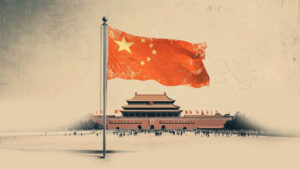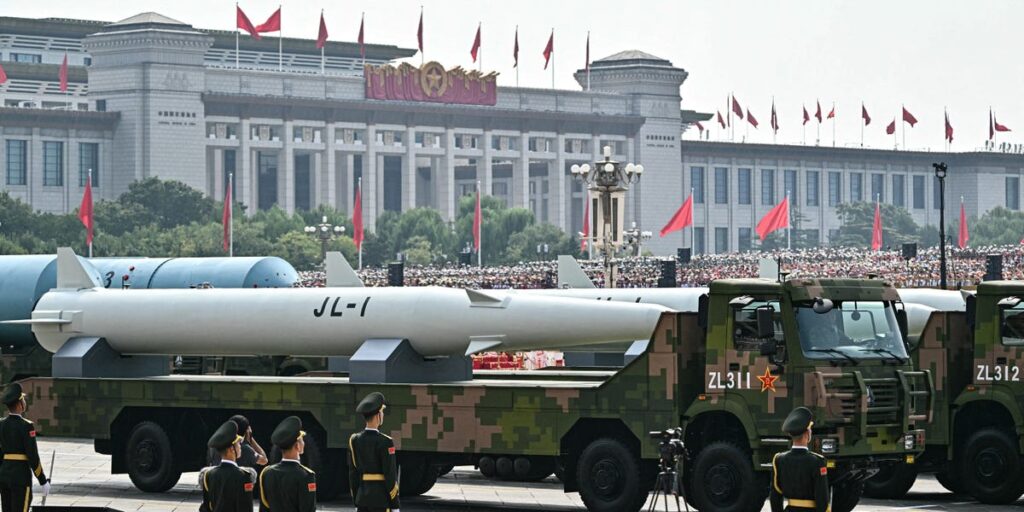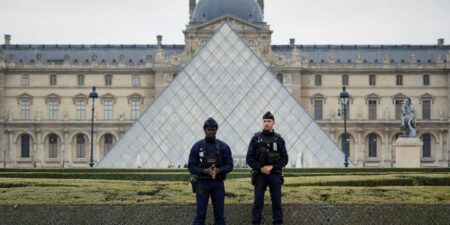China unveiled its arsenal of land-, sea-, and air-launched nuclear missiles at a major military parade on Wednesday, marking the first time that Beijing has publicly showcased its full nuclear triad together.
The parade through Tiananmen Square commemorating the 80th anniversary of Japan’s defeat in World War II featured China’s DF-61, which is believed to be its newest land-based intercontinental ballistic missile, and the DF-31BJ, an upgraded version of older ICBM models.
For now, little is known about either system, including their operational status. Even if these systems are developmental, China has a sizable arsenal of land-based ICBMs.
The military parade also featured the JL-3 submarine-launched ICBM and the debut of the JL-1, an air-launched long-range missile, and other nuclear-armed weapons, like the massive DF-5C silo-launched missile.
Chinese state media touted the display as the first time Beijing has revealed its full nuclear triad, a term for a country’s land, sea, and air nuclear-strike components. Only three other countries — the US, Russia, and India — also have this capability.
Ankit Panda, a senior fellow in the nuclear policy program at the Carnegie Endowment for International Peace, said that the introduction of the JL-1 missile means that the People’s Liberation Army Air Force (PLAAF) has now been formally nuclearized.
“Prior to this, the PLAAF did not have an acknowledged nuclear role,” he told Business Insider, though there were indications that it would serve that purpose.
In 2020, the PLAAF operationally fielded the H-6N, its first nuclear-capable bomber that can be refueled mid-flight, a platform for the air component of China’s nuclear triad. Beijing is also developing a stealth bomber known as the H-20.
A 2024 Department of Defense report on China’s military said the H-20’s development reflects the PLAAF’s effort to “extend its power projection capability.”
Panda said the significance of the full nuclear triad on display at the parade on Wednesday is “debatable.”
“There’s no sacrosanct reason that nuclear delivery systems distributed across land, air, and sea are essential for deterrence,” he said, “but this has widely been seen as a mark of prestige ever since the US and the Soviet Union adopted similar postures during the Cold War.”
A growing arsenal
China is estimated to have over 600 operational nuclear warheads as of 2024, according to last year’s Pentagon report.
That is a much smaller stockpile than the 4,300 and 3,700 warheads that Russia and the US, respectively, possess, according to the Federation of American Scientists. But the Pentagon highlighted in its report that China is engaged in “rapid nuclear expansion.”
China will have more than 1,000 operational nuclear warheads by 2030, “much of which will be deployed at higher readiness levels, and will continue growing its force to 2035 in line with its goal of ensuring PLA modernization is ‘basically complete’ that year,” the Pentagon said.
The US called this “an important milestone” for China’s leader, Xi Jinping, who wants to achieve a ” world-class” military by 2049. That description implies parity with top forces.
China has hundreds of ICBMs in its arsenal, all of which can travel thousands of miles to reach the continental US. The DF-41, predecessor to the DF-61, for instance, has an estimated reach of over 7,500 miles and can carry multiple warheads. China also possesses many theater ballistic missiles, as well as cruise missiles.
The JL-3 that appeared at Wednesday’s parade is China’s third-generation submarine-launched ballistic missile. This weapon, along with its predecessor, the JL-2, can be carried by Beijing’s Jin-class submarines. The country is developing a next-generation of ballistic missile subs.
And then unlike China’s other bomber aircraft, the H-6N has a modified fuselage that allows it to carry, externally, a nuclear-capable air-launched ballistic missile. The Pentagon report said it could likely be used to “conduct nuclear precision strikes against targets in the Indo-Pacific theater.”
Chinese state media said the weapons on display at the parade “are China’s strategic ‘ace’ power to safeguard the country’s sovereignty and nation’s dignity.”
China’s primary rival, the US, fields a robust nuclear triad composed of land-based Minuteman III ICBMs—soon to be replaced by the Sentinel program, nuclear-capable B-52 Stratofortress and B-2 Spirit bombers, with the B-21 Raider entering service, and Ohio-class ballistic missile submarines armed with Trident II D5 missiles, to be succeeded by the Columbia class.
This triad provides Washington with a diverse, flexible, and survivable arsenal of delivery systems that underpins its role as a major nuclear power.
Read the full article here
















